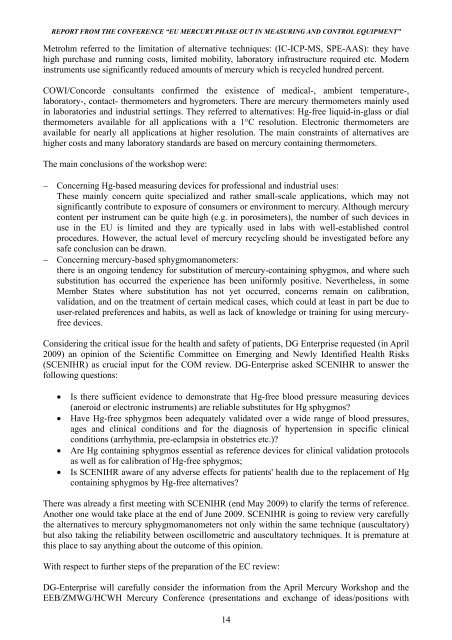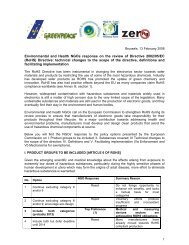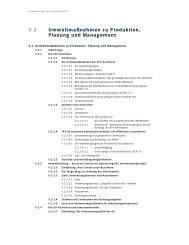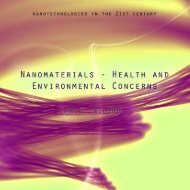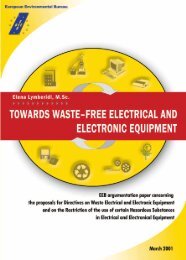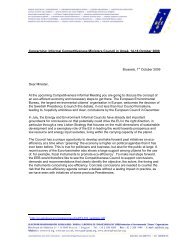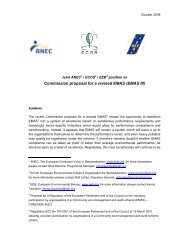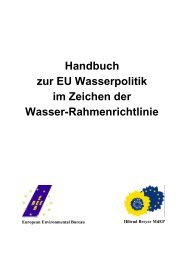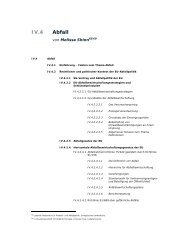Eu Mercury phase out in Measuring and Control Equipment - EEB
Eu Mercury phase out in Measuring and Control Equipment - EEB
Eu Mercury phase out in Measuring and Control Equipment - EEB
You also want an ePaper? Increase the reach of your titles
YUMPU automatically turns print PDFs into web optimized ePapers that Google loves.
REPORT FROM THE CONFERENCE “EU MERCURY PHASE OUT IN MEASURING AND CONTROL EQUIPMENT”Metrohm referred to the limitation of alternative techniques: (IC-ICP-MS, SPE-AAS): they havehigh purchase <strong>and</strong> runn<strong>in</strong>g costs, limited mobility, laboratory <strong>in</strong>frastructure required etc. Modern<strong>in</strong>struments use significantly reduced amounts of mercury which is recycled hundred percent.COWI/Concorde consultants confirmed the existence of medical-, ambient temperature-,laboratory-, contact- thermometers <strong>and</strong> hygrometers. There are mercury thermometers ma<strong>in</strong>ly used<strong>in</strong> laboratories <strong>and</strong> <strong>in</strong>dustrial sett<strong>in</strong>gs. They referred to alternatives: Hg-free liquid-<strong>in</strong>-glass or dialthermometers available for all applications with a 1°C resolution. Electronic thermometers areavailable for nearly all applications at higher resolution. The ma<strong>in</strong> constra<strong>in</strong>ts of alternatives arehigher costs <strong>and</strong> many laboratory st<strong>and</strong>ards are based on mercury conta<strong>in</strong><strong>in</strong>g thermometers.The ma<strong>in</strong> conclusions of the workshop were: Concern<strong>in</strong>g Hg-based measur<strong>in</strong>g devices for professional <strong>and</strong> <strong>in</strong>dustrial uses:These ma<strong>in</strong>ly concern quite specialized <strong>and</strong> rather small-scale applications, which may notsignificantly contribute to exposure of consumers or environment to mercury. Although mercurycontent per <strong>in</strong>strument can be quite high (e.g. <strong>in</strong> porosimeters), the number of such devices <strong>in</strong>use <strong>in</strong> the EU is limited <strong>and</strong> they are typically used <strong>in</strong> labs with well-established controlprocedures. However, the actual level of mercury recycl<strong>in</strong>g should be <strong>in</strong>vestigated before anysafe conclusion can be drawn. Concern<strong>in</strong>g mercury-based sphygmomanometers:there is an ongo<strong>in</strong>g tendency for substitution of mercury-conta<strong>in</strong><strong>in</strong>g sphygmos, <strong>and</strong> where suchsubstitution has occurred the experience has been uniformly positive. Nevertheless, <strong>in</strong> someMember States where substitution has not yet occurred, concerns rema<strong>in</strong> on calibration,validation, <strong>and</strong> on the treatment of certa<strong>in</strong> medical cases, which could at least <strong>in</strong> part be due touser-related preferences <strong>and</strong> habits, as well as lack of knowledge or tra<strong>in</strong><strong>in</strong>g for us<strong>in</strong>g mercuryfreedevices.Consider<strong>in</strong>g the critical issue for the health <strong>and</strong> safety of patients, DG Enterprise requested (<strong>in</strong> April2009) an op<strong>in</strong>ion of the Scientific Committee on Emerg<strong>in</strong>g <strong>and</strong> Newly Identified Health Risks(SCENIHR) as crucial <strong>in</strong>put for the COM review. DG-Enterprise asked SCENIHR to answer thefollow<strong>in</strong>g questions:Is there sufficient evidence to demonstrate that Hg-free blood pressure measur<strong>in</strong>g devices(aneroid or electronic <strong>in</strong>struments) are reliable substitutes for Hg sphygmos?Have Hg-free sphygmos been adequately validated over a wide range of blood pressures,ages <strong>and</strong> cl<strong>in</strong>ical conditions <strong>and</strong> for the diagnosis of hypertension <strong>in</strong> specific cl<strong>in</strong>icalconditions (arrhythmia, pre-eclampsia <strong>in</strong> obstetrics etc.)?Are Hg conta<strong>in</strong><strong>in</strong>g sphygmos essential as reference devices for cl<strong>in</strong>ical validation protocolsas well as for calibration of Hg-free sphygmos;Is SCENIHR aware of any adverse effects for patients' health due to the replacement of Hgconta<strong>in</strong><strong>in</strong>g sphygmos by Hg-free alternatives?There was already a first meet<strong>in</strong>g with SCENIHR (end May 2009) to clarify the terms of reference.Another one would take place at the end of June 2009. SCENIHR is go<strong>in</strong>g to review very carefullythe alternatives to mercury sphygmomanometers not only with<strong>in</strong> the same technique (auscultatory)but also tak<strong>in</strong>g the reliability between oscillometric <strong>and</strong> auscultatory techniques. It is premature atthis place to say anyth<strong>in</strong>g ab<strong>out</strong> the <strong>out</strong>come of this op<strong>in</strong>ion.With respect to further steps of the preparation of the EC review:DG-Enterprise will carefully consider the <strong>in</strong>formation from the April <strong>Mercury</strong> Workshop <strong>and</strong> the<strong>EEB</strong>/ZMWG/HCWH <strong>Mercury</strong> Conference (presentations <strong>and</strong> exchange of ideas/positions with14


